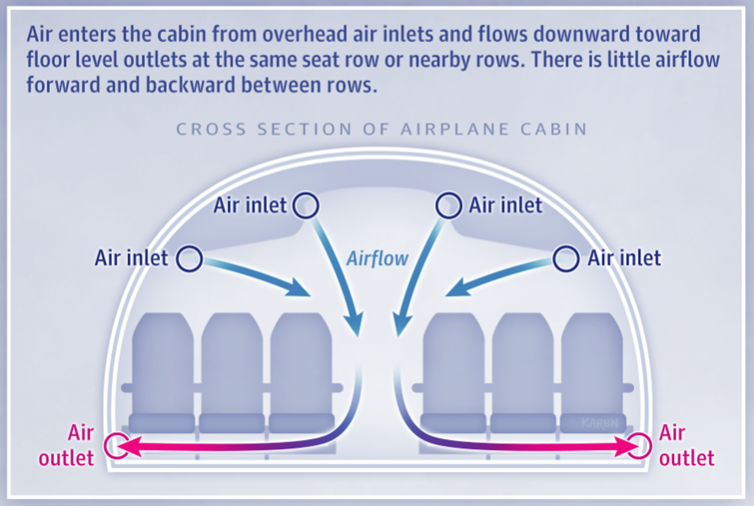Issue
- What is the risk of passenger-to-passenger COVID-19 transmission aboard an aircraft?
Background and Discussion
- Media reports and scientific journal articles have conveyed both concerning and reassuring messages about the risk of COVID-19 transmission aboard aircraft.
- While it is true that air travel can result in the importation of passengers with COVID-19,[1] the risk of spread of COVID-19 amongst passengers while traveling aboard aircraft appears to be low.
- The European Centre for Disease Prevention and Control (ECDC) has commented on the risk of COVID-19 transmission on aircraft: “The risk of being infected on an airplane cannot be excluded, but is currently considered to be low for an individual traveller.”[2]
- IATA press release stated: “The risk of a passenger contracting COVID-19 while onboard appears very low. With only 44 identified potential cases of flight-related transmission among 1.2 billion travelers, that’s one case for every 27 million travelers. We recognize that this may be an underestimate but even if 90% of the cases were un-reported, it would be one case for every 2.7 million travelers.”[3]
- A recent study conducted by Defence Advanced Research Projects Agency (DARPA) for the United States Transport Command (TRANSCOM) investigated aerosol dispersion aboard Boeing 767/777 aircraft.[4]
- Reported findings include:
- 99.7% reduction of from aerosolized exposure in nearby seat with the highest measured exposure level
- Average of 99.99% reduction from aerosolized exposure across the approximately 40 other seats nearby the simulated infected passenger
- “Transmission model calculations with a 4,000 viruses/hour shedding rate and 1,000 virus infectious dose show a minimum 54 flight hours required to produce inflight infection from aerosol transmission.”
- Report limitations:
- Defence Advanced Research Projects Agency (DARPA) scientists emphasized the study limitations and their focus on aerosol exposure (rather than disease transmission) during a recent teleconference 22 October 2020.
- The COVID-19 infectious dose (required number of virions) is unknown in humans and estimates vary in multiple orders of magnitude. The number of virions shed by an infectious person is also unknown and variable.
- Testing did not incorporate large droplets. Large droplets co-release with aerosols when talking, sneezing or coughing. They may result in transmission directly or via surfaces. Risk of contamination via large droplets is likely increased in lavoratories and other common areas.
- Human behavior, such as conversations and moving around the aircraft were not simulated (testing mannequin remained facing forward).
- Reported findings include:
- The true rate of COVID-19 transmission during flight is difficult to ascertain due to the low percentage of passengers tested, limited contact tracing, and difficulty proving transmission occurred during a flight.
- A number of interacting factors aboard an aircraft are likely responsible for the relatively low risk of spread of COVID-19 amongst passengers, even in circumstances where physical distance between passengers is reduced, including:
- Air quality.
- Overall, the United States Centers for Disease Control (CDC) states that “[m]ost viruses and other germs do not spread easily on flights because of how air circulates and is filtered on airplanes.”[5]
- Airflow direction described by recent JAMA publication states: “Air enters the cabin from overhead inlets and flows downwards toward floor-level outlets. Air enters and leaves the cabin at the same seat row or nearby rows. There is relatively little airflow forward and backward between rows, making it less likely to spread respiratory particles between rows.”[6] (see figure 1 below).
- Air exchange rate in modern jet airliners is much higher than a typical home and even higher than recommended design specifications for modern hospital operating and patient isolation rooms.4
-
Air filtration in many modern jet airliners uses highly effective HEPA filters.

Figure 1 Aircraft air circulation[6]
- Face masks. The addition of mask-wearing adds a further and significant layer of protection. TRANSCOM/DARPA study reported “application of a mask provided significant protection against micron diameter droplets released during the cough simulations and reductions greater than 90% were measured.” Lack of transmission in the CMAJ case was partly attributed to masking in April 2020.[7] Masks are mandatory for air travelers and crew under the current Interim Order.
- Cabin characteristics: Other features of aircraft interiors may reduce the likelihood of COVID-19 transmission, including: seat backs serving as physical barriers, reduced face-to-face interactions, and limited passenger mixing when seated.[8]
- Additional measures: Airports and airlines have implemented a multi-layered approach to reduce COVID-19 transmission. In addition to those described above, measures include symptom screening; temperature screening; enhanced cleaning and disinfection; increased use of contactless boarding/baggage processing; use of physical barriers and sanitization in airports; physical distancing in airports and during boarding; adjustment of food and beverage service to reduce contact; control of access to aisles and bathrooms to minimize contact.
- Air quality.
Assessment
- Available evidence suggests that the likelihood of passenger-to-passenger transmission aboard aircraft appears to be low. However, accurate estimation is difficult due to limited passenger testing, contact tracing, and difficulty proving transmission aboard an aircraft.
Date prepared: 4 November 2020
References
[1] Adiga A, et al. Evaluating the impact of international airline suspensions on the early global spread of COVID-19. medRxiv preprint doi: https://doi.org/10.1101/2020.02.20.20025882.this version posted March 2, 2020.
[3] IATA press release 8 October 2020: Research Points to Low Risk for COVID-19 Transmission Inflight
[5] https://www.cdc.gov/coronavirus/2019-ncov/travelers/faqs.html#Air-or-Cruise-Travel
[6] JAMA. 2020;324(17):1798. doi:10.1001/jama.2020.19108
[7] Schwartz K et al. Lack of COVID transmission aboard and international flight. Canadian Medical Association Journal. April 14, 2020 192 (15) E410; DOI: https://doi.org/10.1503/cmaj.75015
[8] IATA press release 8 October 2020: Research Points to Low Risk for COVID-19 Transmission Inflight